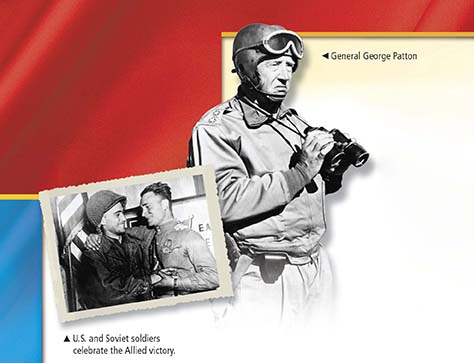SECTION 1: The Cold War Begins

WITNESS HISTORY  AUDIO
AUDIO
A New Enemy
After World War II, U.S. General George Patton administered western Germany, while Soviet officials governed eastern Germany. Patton looked to the east and proclaimed:
“Russia knows what she wants. World domination! … Let’s keep our boots polished, bayonets sharpened, and present a picture of force and strength to the Russians. This is the only language that they understand and respect. If we fail to do this, then I would like to say that we have had a victory over the Germans and have disarmed them, but we have lost the war.”
—General George S. Patton, October 1945
Objectives
- Trace the reasons that the wartime alliance between the United States and the Soviet Union unraveled.
- Explain how President Truman responded to Soviet domination of Eastern Europe.
- Describe the causes and results of Stalin’s blockade of Berlin.
Terms and People
- satellite state
- Cold War
- iron curtain
- Truman Doctrine
- George F. Kennan
- containment
- Marshall Plan
- Berlin airlift
- NATO
- Warsaw Pact
NoteTaking
Reading Skill: Contrast As you read, contrast the conflicting goals of the United States and the Soviet Union.
| American Goals | Soviet Goals |
Why It Matters In the 1930s, the policies of isolationism and appeasement had contributed to the rise of dictatorships and the outbreak of global war. After World War II, U.S. leaders viewed these past policies as mistakes. They sought new ways to keep the United States safe and to protect its interests around the world. Section Focus Question: How did U.S. leaders respond to the threat of Soviet expansion in Europe?
Roots of the Cold War
When Franklin Roosevelt died in April 1945, the nation was at a critical point. The United States was still at war. In addition, relations with the Soviet Union—one of the most important wartime allies—were beginning to break down.
American and Soviet Systems Differ
The United States and the Soviet Union had been united only in their opposition to Nazi Germany. Beyond that, they had little in common. The United States was a capitalist democracy. Its citizens believed in free elections, economic and religious freedom, private property, and respect for individual differences. The Soviet Union was a dictatorship. Under Joseph Stalin, the Communist Party made all key economic, political, and military decisions. The Soviet people could not worship as they pleased, own private property, or express their views freely. Those who opposed or questioned Stalin risked imprisonment and death.




